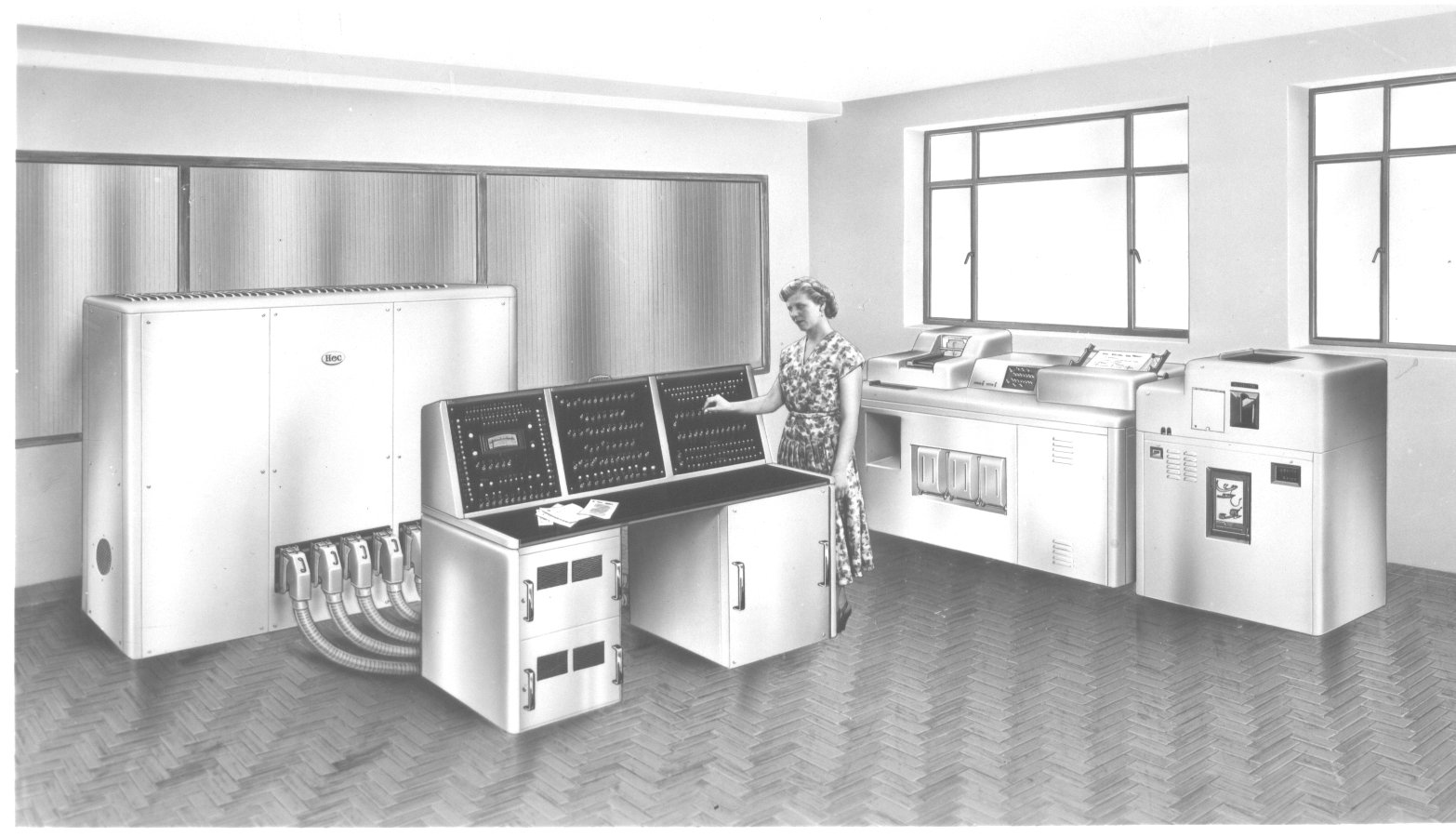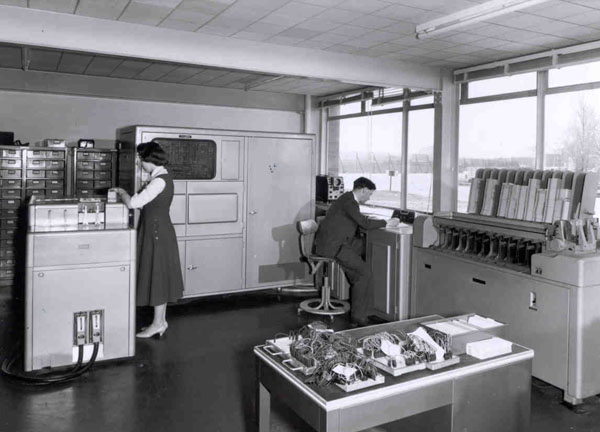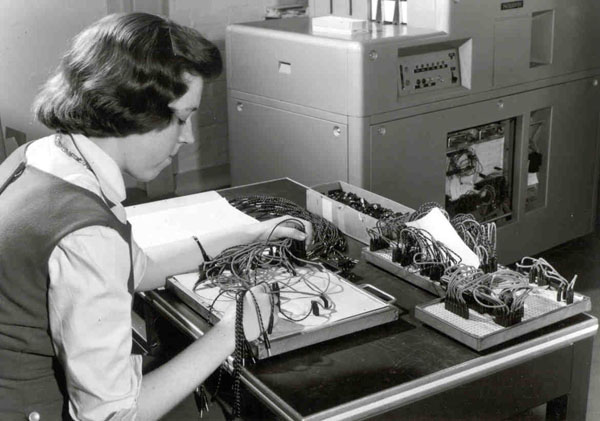

In Jack Howlett's photographs was a set of the prototype Ferranti Mark 1* and another mystery photograph (originally thought to be one of the Mark 1) which turned out to be the BTM 1202. We do not believe Harwell ever purchased the machine but were interested in it. Thanks to Jitze Couperus for unearthing the truth!

The British Tabulating Machine Company became interested in Booth's work and derived their HEC (Hollerith Electronic Computer) from his APE(R)C project. The nomenclature arose because BTM punched-card equipment had always been known as Hollerith machines, in recognition of their historic link with Herman Hollerith and to distinguish them from Powers machines. A prototype HEC was exhibited at the Business Efficiency Exhibition in London in 1953. HEC was first marketed as the BTM 1200 computer in 1954, in which year five were sold. The first business data processing version, the BTM 1201, had an enlarged 1024-word drum store and was first delivered in 1956; 70 such machines were eventually sold.
Just to clarify the nomenclature - the original machine as built by Booth at Birkbeck College was variously known as the Hec (Hollerith Electronic Computer) and as the 1200. When BTM took over production, the first models they delivered were still designated as Hec but with the number 1201. The 1201 used the BTM Rolling Total Tabulator and associated summary punch for its peripherals (Card reader, punch, printer). The card-reader/line-printer unit on this production machine was based on the JRTT (Junior Rolling Total Tabulator) or SRTT (Senior Rolling Total Tabulator) depending on customer choice - the main difference between these two being number of print positions (width) of the printer.
A year or two later, BTM came out with a new line of tabulators (the 900 series) which were much more flexible and powerful, and a new new model of the Hec was introduced - the 1202 - using a derivative from this newer line of kit for its card-reader/line-printer.
The machine depicted above however is I think a 1202 , the main difference from the 1201 being that it sported the later 900 series tabulator for its card-reading and line-printing capability - notice the modern skins on the tabulator and triple plug panels rather than the older typical Hollerith Queen Anne legs.
But more telling on closer examination of this picture is the logo in the middle of the center panel of the main CPU box which clearly says HEC. (If your browser automatically does a shrink-to-fit-the-screen with large images, you will need to expand this picture to read the logo).
The physical componentry of the HEC machine (as opposed to the internal logic) was cobbled together from technology first developed for the BTM 542 and 550 calculators and eventually the 555 computer.


The 542 (and its larger brother the 550) were calculators rather than computers in that they had a finite number of pluggable steps for programming and no storage beyond the registers themselves. Any computation involved had also to be completed within the short space of time between when a card was read (passing under the read station) and when it reached the punch station where output results would be punched back into different columns of the same card.
The 555 however was a major step up - it had a drum for storage, and a card could be stopped in its tracks pending completion of any computation, and eventual passage of the card under the punch station. I know Harwell used this machine extensively.
The drum technology as well as much of the electronics (turrets with fundamental circuit components such as logic gates, adders, etc.) of the 555 went into the HEC with any necessary adaptation.
I worked on a HEC machine at the (euphemistically named) Cambridge Language Computing Laboratory and can confirm that the operator's console in this picture is that of a HEC - very different from that of the "real" Ferranti MK1 as shown in the other picture referenced above.
The pictures on this site of the 555 and HEC 1202 are very rare - another picture of a BTM HEC on the web (and labelled as such) is at http://web.onetel.com/~rodritab/shed13.htm.
This clearly depicts the same type of box as shown above so I'm as sure as I can be - note that in this picture it is identified (within the original image as opposed to an external caption) as BTM Hec 4 - that clinches it for me! So technically they are both 1202.
As an amusing aside - at the time this machine was built, the headquarters of BTM (ICT) was a building in Hyde Park Lane (near today's Hilton, close to Wellington Monument) but expansion of the company dictated that a new HQ building was required. A couple of engineers were then planning a successor to the 1200 Hec machine-line - tentatively identified as the 1400 - but that never got beyond some back-of-the-envelope sketches as other events (the ICT 1301 as developed by GEC) took over. Nevertheless, these preliminary sketches showed that a machine as envisaged would put a huge thermal load inside the building that would need to be dissipated somehow - so the advice was to have a building on the banks of e.g. the Thames so that lots of water could be diverted from the river to accomplish this. Thus the new building came to be built on the north side of Putney Bridge and huge pipes were laid on, to and from the river. These were still there when last I visited the site some 20 years ago... Later ICT (ICL) also took over a second building on the south side of the bridge - originally built for Hotpoint - but I have since heard that ICL is no longer in the north-end building.
I can remember the essence of a meeting we had at the time - it was known that transistors were in the offing, but it was confidently asserted that these were unlikely to ever play a major role in computer design - their switching speeds were too low and they were too expensive. A thermionic valve at that time could switch well into the high megacycle range (as in Radar) and cost between 5 and 10 shillings. A transistor however could barely reach a megacycle and cost from five to twenty-five times as much... So much for that line of thought.